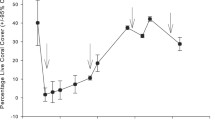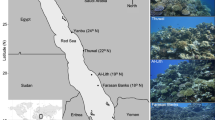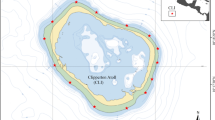Abstract
“Refuge theory” suggests that global warming would be beneficial to corals in high latitude waters. In theory, then, the Weizhou Island reef (21°00′–21°10′N, 109°00′–109°15′E), which is located in a relatively high latitude area in the northern South China Sea, is a refuge for corals under global warming. Yet, the corals here have degenerated significantly. We investigated the ecological status of the Weizhou Island reef in 2015 and recorded 11 families, 22 genera, and 41 coral species. The mean living coral cover has decreased from ~ 42% in 1984 to ~ 10% in 2015 and there are many dead Acropora in the study area, especially at the reef flat. Coral assemblage structure has undergone degradation with the dominant group shifting from high complexity branching, foliaceous and massive colonies to a simpler group of massive morphologies. The only sign indicating the corals here benefiting from global warming is the occurrence of a large amount of juvenile Porites lutea (31.91% of the total population), which represents the recovery potential of the Weizhou Island reefs. Further analysis concludes that the main reason for the rapid degeneration is escalating anthropogenic impact, such as seawater pollution, unsustainable tourism activities, ongoing overfishing, all of which degrade the local ecological environment. It seems that intensive anthropogenic activities have weakened the “refuge” function significantly. Decreasing living coral cover as well as degraded assemblage structure all suggest that Weizhou Island offers limited potential as refuge habitat for corals in the context of global warming and intensive human activities.










Similar content being viewed by others
References
Abdo DA, Bellchambers LM, Evans SN (2012) Turning up the heat: increasing temperature and coral bleaching at the high latitude coral reefs of the Houtman Abrolhos Islands. PLoS ONE 7:e43878
Adjeroud M, Kayal M, Iborra-Cantonnet C et al (2018) Recovery of coral assemblages despite acute and recurrent disturbances on a South Central Pacific reef. Sci Rep. https://doi.org/10.1038/s41598-018-27891-3
Bak RPM, Meesters EH (1998) Coral population structure: the hidden information of colony size-frequency distributions. Mar Ecol Prog Ser 162:301–306. https://doi.org/10.3354/meps162301
Beger M, Sommer B, Harrison PL, Smith SDA, Pandolfi JM, Cowie R (2014) Conserving potential coral reef refuges at high latitudes. Divers Distrib 20:245–257. https://doi.org/10.1111/ddi.12140
Bell PRF (1991) Status of eutrophication in the Great Barrier Reef lagoon. Mar Pollut Bull 23:89–93. https://doi.org/10.1016/0025-326X(91)90655-C
Bell PRF (1992) Eutrophication and coral reefs—some examples in the Great Barrier Reef lagoon. Water Res 26:553–568. https://doi.org/10.1016/0043-1354(92)90228-V
Box SJ, Mumby PJ (2007) Effect of macroalgal competition on growth and survival of juvenile Caribbean corals. Mar Ecol Prog Ser 342:139–149. https://doi.org/10.3354/meps342139
Butler IR, Sommer B, Zann M, Zhao JX, Pandolfi JM (2013) The impacts of flooding on the high-latitude, terrigenoclastic influenced coral reefs of Hervey Bay, Queensland, Australia. Coral Reefs 32:1149–1163. https://doi.org/10.1007/s00338-013-1064-7
Chen TR, Yu KF, Shi Q et al (2009) Twenty-five years of change in scleractinian coral communities of Daya Bay (northern South China Sea) and its response to the 2008 AD extreme cold climate event. Chin Sci Bull 54:2107–2117. https://doi.org/10.1007/s11434-009-0007-8
Chen TR, Li S, Yu KF, Zheng ZY, Wang LR, Chen TG (2013a) Increasing temperature anomalies reduce coral growth in the Weizhou Island, northern South China Sea. Estuar Coast Shelf Sci 130:121–126. https://doi.org/10.1016/j.ecss.2013.05.009
Chen TR, Zheng ZY, Mo SH, Tang CL, Zhou X (2013b) Bioerosion in Porites corals at Weizhou Island and its environmental significance. Chin Sci Bull 58:1574–1582. https://doi.org/10.1360/972011-2531
Chen TR, Zheng ZY, Mo SH, Zhou X, Chen TG (2013c) Variation of skeletal extension rate for Porites corals around Weizhou Island in response to global warming and increase of extreme events. J Trop Oceanogr 32:79–84. https://doi.org/10.3969/j.issn.1009-5470.2013.05.011
Costa OS, Nimmo M, Attrill MJ (2008) Coastal nutrification in Brazil: a review of the role of nutrient excess on coral reef demise. J South Am Earth Sci 25:257–270. https://doi.org/10.1016/j.jsames.2007.10.002
Crossland CJ (1984) Seasonal variations in the rates of calcification and productivity in the coral Acropora formosa on a high-latitude reef. Mar Ecol Prog 15:135–140. https://doi.org/10.3354/meps015135
Darling ES, McClanahan TR, Côté IM (2010) Combined effects of two stressors on Kenyan coral reefs are additive or antagonistic, not synergistic. Conserv Lett 3:122–130. https://doi.org/10.1111/j.1755-263X.2009.00089.x
De’ath G, Fabricius KE, Sweatman H, Puotinen M (2012) The 27-year decline of coral cover on the Great Barrier Reef and its causes. Proc Nat Acad Sci USA 109:17995–17999. https://doi.org/10.1073/pnas.1208909109
DeBose JL, Nuttall MF, Hickerson EL, Schmahl GP (2013) A high-latitude coral community with an uncertain future: Stetson Bank, northwestern Gulf of Mexico. Coral Reefs 32:255–267. https://doi.org/10.1007/s00338-012-0971-3
Denis V, Mezaki T, Tanaka K, Kuo CY, De Palmas S, Keshavmurthy S, Chen CA (2013) Coverage, diversity, and functionality of a high-latitude coral community (Tatsukushi, Shikoku Island, Japan). PLoS ONE 8:e54330. https://doi.org/10.1371/journal.pone.0054330.g001
Edmunds PJ (2000) Patterns in the distribution of juvenile corals and coral reef community structure in St. John, US Virgin Islands. Mar Ecol Prog Ser 202:113–124. https://doi.org/10.3354/meps202113
Edwards AJ, Clark S, Zahir H, Rajasuriya A, Naseer A, Rubens J (2001) Coral bleaching and mortality on artificial and natural reefs in Maldives in 1998, sea surface temperature anomalies and initial recovery. Mar Pollut Bull 42:7–15. https://doi.org/10.1016/S0025-326x(00)00200-9
English S, Wilkinson C, Baker V (1997) Survey manual for tropical marine resources. Australian Institute Marine Science, Townsville
Fabricius KE (2005) Effects of terrestrial runoff on the ecology of corals and coral reefs: review and synthesis. Mar Pollut Bull 50:125–146. https://doi.org/10.1016/j.marpolbul.2004.11.028
Fine M, Gildor H, Genin A (2013) A coral reef refuge in the Red Sea. Glob Change Biol 19:3640–3647. https://doi.org/10.1111/gcb.12356
Foster MS, Harrold C, Hardin DD (1991) Point vs. photo quadrat estimates of the cover of sessile marine organisms. J Exp Mar Biol Ecol 146:193–203. https://doi.org/10.1016/0022-0981(91)90025-R
Gj M (1995) Ethnobotany: a methods manual. Chapman and Hall, London
Glynn PW (1996) Coral reef bleaching: facts, hypotheses and implications. Glob Change Biol 2:495–509. https://doi.org/10.1111/j.1365-2486.1996.tb00063.x
Greenstein BJ, Pandolfi JM (2008) Escaping the heat: range shifts of reef coral taxa in coastal Western Australia. Glob Change Biol 14:513–528. https://doi.org/10.1111/j.1365-2486.2007.01506.x
Guangxi Mangrove Research Center (2006) Survey report on Weizhou Island Reef resources. Guangxi Mangrove Research Center, Beihai
Halfar J, Godinez-Orta L, Riegl B, Valdez-Holguin JE, Borges JM (2005) Living on the edge: high-latitude Porites carbonate production under temperate eutrophic conditions. Coral Reefs 24:582–592. https://doi.org/10.1007/s00338-005-0029-x
Han LJ, Zheng XQ, Lan WL, Shi XF, Li TS (2015) Variations of nutrients concentration in surface seawater in adjacent area of Weizhou Island in recent 10 years. J Appl Oceanogr 34:65–72. https://doi.org/10.3969/J.ISSN.2095-4972.2015.01.009
Hill J, Wilkinson C (2004) Methods for ecological monitoring of coral reefs. Australian Institute of Marine Science, Townsville
Hoegh-Guldberg O (1999) Climate change, coral bleaching and the future of the world’s coral reefs. Mar Freshw Res 50:839–866. https://doi.org/10.1071/MF99078
Hoegh-Guldberg O, Fine M (2004) Low temperatures cause coral bleaching. Coral Reefs 23:444–444. https://doi.org/10.1007/s00338-004-0401-2
Hoegh-Guldberg O, Mumby PJ, Hooten AJ et al (2007) Coral reefs under rapid climate change and ocean acidification. Science 318:1737–1742. https://doi.org/10.1126/science.1152509
Huang JS, Zhang YL (1987) Coast sedimentary of corals at Weizhou Island reef, Beibu Gulf. Trop Landf 8:1–3
Huang H, Ma BR, Lian JS, Yang JH, Dong ZJ, Fu Q, Liang W (2009) Status and conservation strategies of coral reef in Weizhou Island, Guangxi. Trop Geogr 29:307–312. https://doi.org/10.3969/j.issn.1001-5221.2009.04.001
Hughes TP, Graham NA, Jackson JB, Mumby PJ, Steneck RS (2010) Rising to the challenge of sustaining coral reef resilience. Trends Ecol Evol 25:633–642. https://doi.org/10.1016/j.tree.2010.07.011
Hughes TP, Kerry JT, Simpson T (2018) Large-scale bleaching of corals on the Great Barrier Reef. Ecology 99:501–501. https://doi.org/10.1002/ecy.2092
Jackson JBC, Donovan MK, Cramer KL, Lam V (2014) Status and trends of Caribbean coral reefs: 1970-2012. Global Coral Reef Monitoring Network, IUCN, Gland
Jokiel PL, Rodgers KS (2007) Ranking coral ecosystem “health and value” for the islands of the Hawaiian Archipelago. Pac Conserv Biol 13:60–68. https://doi.org/10.1071/PC070060
Jordan LKB, Banks KW, Fisher LE, Walker BK, Gilliam DS (2010) Elevated sedimentation on coral reefs adjacent to a beach nourishment project. Mar Pollut Bull 60:261–271. https://doi.org/10.1016/j.marpolbul.2009.08.032
Kenyon JC, Wilkinson CB, Aeby GS (2008) Community structure of hermatypic corals at Maro Reef in the northwestern Hawaiian Islands: a unique open atoll. Atoll Res Bull 558:1–22. https://doi.org/10.5479/si.00775630.558.1
Kleypas JA, McManus JW, Menez LAB (1999) Environmental limits to coral reef development: where do we draw the line? Am Zool 39:146–159. https://doi.org/10.1093/icb/39.1.146
Koop K, Booth D, Broadbent A et al (2001) ENCORE: the effect of nutrient enrichment on coral reefs. Synthesis of results and conclusions. Mar Pollut Bull 42:91–120. https://doi.org/10.1016/S0025-326X(00)00181-8
Krieger JR, Chadwick NE (2013) Recreational diving impacts and the use of pre-dive briefings as a management strategy on Florida coral reefs. J Coast Conserv 17:179–189. https://doi.org/10.1007/s11852-012-0229-9
Kuo CY, Yuen YS, Meng PJ et al (2012) Recurrent disturbances and the degradation of hard coral communities in Taiwan. PLoS ONE 7:e44364. https://doi.org/10.1371/journal.pone.0044364
Li S, Yu KF, Shi Q, Chen TR, Zhao MX, Zhao JX (2008) Interspecies and spatial diversity in the symbiotic zooxanthellae density in corals from northern South China Sea and its relationship to coral reef bleaching. Chin Sci Bull 53:295–303. https://doi.org/10.1007/s11434-007-0514-4
Li MM, Zhong WP, Xu JS (2016) Analysis of environmental change around Weizhou Island seawater in recent 5 year based on automatic water quality monitoring network. Nat Sci 11:117–118
Liang X, Peng ZC (2018) Analysis and appraisal of seawater quality in coral reef water, Weizhou Island, Guangxi. Ocean Dev Man 35:114–119. https://doi.org/10.3969/j.issn.1005-9857.2018.01.020
Liang W, Li GZ, Fan HQ, Nong HQ, Wang X (2010a) Study on the species diversity of coral reef on Weizhou Island, Guangxi. Mar Sci Bull 29:412–416. https://doi.org/10.1631/jzus.a1000244
Liang W, Li GZ, Fan HQ et al (2010b) Species composition and distribution of coral on Weizhou Island Guangxi. Guangxi Sci 17:93–96. https://doi.org/10.3969/j.issn.1005-9164.2010.01.025
Liang W, Zhang CH, Ye ZC, Li GZ, Nong HQ, Wang X (2011) Spatial pattern of scleractinian coral population structure in Weizhou Island, Beihai, Guangxi. Acta Ecol Sin 31:39–46
Liu JH, Li GZ, Nong HQ (1991) Features of geomorphy and Quaternary geology of the Weizhou Island. J Guangxi Acad Sci 7:27–36. https://doi.org/10.3969/j.issn.1001-6392.2008.03.008
Liu PJ, Meng PJ, Liu LL, Wang JT, Leu MY (2012) Impacts of human activities on coral reef ecosystems of southern Taiwan: a long-term study. Mar Pollut Bull 64:1129–1135. https://doi.org/10.1016/j.marpolbul.2012.03.031
Loya Y, Sakai K, Yamazato K, Nakano Y, Sambali H, van Woesik R (2001) Coral bleaching: the winners and the losers. Ecol Lett 4:122–131. https://doi.org/10.1046/j.1461-0248.2001.00203.x
Lybolt M, Neil D, Zhao JX, Feng YX, Yu KF, Pandolfi J (2011) Instability in a marginal coral reef: the shift from natural variability to a human-dominated seascape. Front Ecol Environ 9:154–160. https://doi.org/10.1890/090176
Marshall PA, Baird AH (2000) Bleaching of corals on the Great Barrier Reef: differential susceptibilities among taxa. Coral Reefs 19:155–163. https://doi.org/10.1007/s003380000086
McKenzie VJ, Townsend AR (2007) Parasitic and infectious disease responses to changing global nutrient cycles. EcoHealth 4:384–396. https://doi.org/10.1007/s10393-007-0131-3
Medio D, Ormond RFG, Pearson M (1997) Effect of briefings on rates of damage to corals by scuba divers. Biol Conserv 79:91–95. https://doi.org/10.1016/S0006-3207(96)00074-2
Melese SM, Ayele B (2017) Woody plant diversity, structure and regeneration in the Ambo State Forest, South Gondar Zone, Northwest Ethiopia. J For Res 28:133–144. https://doi.org/10.1007/s11676-016-0280-8
Mo YJ (1989) Development of coastal landform in Weizhou Island. Trop Geogr 9:243–248
National Marine Environmental Monitoring Center (2005) The guidance for the assessment of coastal marine ecosystem health vol HY/T 087-2005. Standards Press of China, Beijing
Oliver TA, Palumbi SR (2011) Do fluctuating temperature environments elevate coral thermal tolerance? Coral Reefs 30:429–440. https://doi.org/10.1007/s00338-011-0721-y
Pandolfi JM, Connolly SR, Marshall DJ, Cohen AL (2011) Projecting coral reef futures under global warming and ocean acidification. Science 333:418–422. https://doi.org/10.1126/science.1204794
Porter SN, Schleyer MH (2017) Long-term dynamics of a high-latitude coral reef community at Sodwana Bay, South Africa. Coral Reefs 36:369–382. https://doi.org/10.1007/s00338-016-1531-z
Qiu SF, Lai TH, Zhuang JL (2005) A case analysis of the Microcystis aeruginosa red tide occurring in the sea field of Nanwan Harbor, Weizhou Island. Guangxi Sci 12:330–333. https://doi.org/10.13656/j.cnki.gxkx.2005.04.026
Riegl B (2003) Climate change and coral reefs: different effects in two high-latitude areas (Arabian Gulf, South Africa). Coral Reefs 22:433–446. https://doi.org/10.1007/s00338-003-0335-0
Riegl B, Piller WE (2003) Possible refugia for reefs in times of environmental stress. Int J Earth Sci 92:520–531. https://doi.org/10.1007/s00531-003-0328-9
Ruzicka RR, Colella MA, Porter JW et al (2013) Temporal changes in benthic assemblages on Florida Keys reefs 11 years after the 1997/1998 El Nino. Mar Ecol Prog Ser 489:125–141. https://doi.org/10.3354/meps10427
Schleyer MH, Kruger A, Celliers L (2008) Long-term community changes on a high-latitude coral reef in the Greater St. Lucia Wetland Park, South Africa. Mar Pollut Bull 56:493–502. https://doi.org/10.1016/j.marpolbul.2007.11.011
Shi HY (2012) Monitoring and evaluation of ecological environment of coral reef areas in Weizhou Island, Beihai, Guangxi. Basic Research, Chinese Marine University
Tang CL, Li M, Zheng ZY, Xj Shi (2010) An analysis on the trend of sea surface temperature indices for coral hot bleaching in Weizhou Island Ocean Observation Station during 1966-2009. Trop Geogr 30:577–581. https://doi.org/10.3969/j.issn.1001-5221.2010.06.001
Thomson DP, Frisch AJ (2010) Extraordinarily high coral cover on a nearshore, high-latitude reef in south-west Australia. Coral Reefs 29:923–927. https://doi.org/10.1007/s00338-010-0650-1
Thurber RLV, Burkepile DE, Fuchs C, Shantz AA, McMinds R, Zaneveld JR (2014) Chronic nutrient enrichment increases prevalence and severity of coral disease and bleaching. Glob Change Biol 20:544–554. https://doi.org/10.1111/gcb.12450
Toksha BG, Shirsath SE, Patange SM, Jadhav KM (2008) Structural investigations and magnetic properties of cobalt ferrite nanoparticles prepared by sol-gel auto combustion method. Solid State Commun 147:479–483. https://doi.org/10.1016/j.ssc.2008.06.040
Toth LT, van Woesik R, Murdoch TJT, Smith SR, Ogden JC, Precht WF, Aronson RB (2014) Do no-take reserves benefit Florida’s corals? 14 years of change and stasis in the Florida Keys National Marine Sanctuary. Coral Reefs 33:565–577. https://doi.org/10.1007/s00338-014-1158-x
Veron JEN (2000) Corals of the world. Australian Institute of Marine Science, Townsville
Vieira C, Keshavmurthy S, Ju SJ et al (2016) Population dynamics of a high-latitude coral Alveopora japonica Eguchi from Jeju Island, off the southern coast of Korea. Mar Freshw Res 67:594–604. https://doi.org/10.1071/MF14330
Wang X (2009) Research of the relationship between the deposit of suspended and the growth of coral reef in Weizhou Island, Beibu Bay. Basic Research, Guangxi University, Nanning
Wang GZ, Lv BQ, Quan SQ (1987) Mixed sedimentation of recent carbonates and terrigenous clastics—example of the coral reef of Weizhou Island. Oil Gas Geol 8:15–26
Wang GZ, Quan SQ, Lv BQ (1991) Evolution of modern sedimentary environments and sedimentations in the Weizhou Island Area, South China Sea. Mar Geol Quat Geol 11:69–82
Wang MG, Wang PL, Mai HL (1998) Preliminary investigation of corals at Weizhou Island in Beibu Gulf, Guangxi. Guangxi Oceanic Administration, Nanning
Wei MX, Li GZ, He BM, Liang W (2005) Preliminory study of the relationship between plankton and environmrntal factors in the coral reef system around Weizhou Island. Trans Oceanol Limnol. https://doi.org/10.13984/j.cnki.cn37-1141.2005.02.006
Wiedenmann J, D’Angelo C, Smith EG, Hunt AN, Legiret FE, Postle AD, Achterberg EP (2013) Nutrient enrichment can increase the susceptibility of reef corals to bleaching. Nat Clim Change 3:160–164. https://doi.org/10.1038/NCLIMATE1661
Yu KF (2012) Coral reefs in the South China Sea: their response to and records on past environmental changes. Sci China Earth Sci 55:1217–1229. https://doi.org/10.1007/s11430-012-4449-5
Yu DP, Zou RL (1996) Current situation and dynamics of species diversity in heramtypic coral community on Luhuitou fringing reef. Acta Ecol Sin 16:559–564
Yu KF, Jiang MX, Cheng ZQ, Chen TG (2004) Latest forty two years’ sea surface temperature change of Weizhou Island and its influence on coral reef ecosystem. Chin J Appl Ecol 15:506–510. https://doi.org/10.13287/j.1001-9332.2004.0110
Zhang QM, Shi Q, Chen G et al (2006) Status monitoring and health assessment of Luhuitou fringing reef of Sanya, Hainan, China. Chin Sci Bull 51:81–88. https://doi.org/10.1007/s11434-006-9081-3
Zhang SF, Li WQ, Lin MY, Wei CL, Lin DK (2009) Preliminary studies on the relationship between red tide in the sea area of Weizhou Island and marine hydrometeorolgy. Guangxi Sci 16:200–202. https://doi.org/10.3969/j.issn.1005-9164
Zhou HL, Li GZ (2014) Assessment on the health of coral reefs at Weizhou Island. J Guangxi Acad Sci 30:238–247. https://doi.org/10.13657/j.cnki.gxkxyxb.20141126.005
Zhou X, Li M, Zheng ZY, Huang HH, Shi XJ (2010) An analysis on the trend of sea surface temperature indices for coral cold bleaching in Weizhou Island Ocean Observation Station during 1960-2009. Trop Geogr 30:582–586. https://doi.org/10.13284/j.cnki.rddl.001408
Zou RL (2001) Fauna sinica-hermatypic coral. Science Press, Beijing
Zou RL, Zhang YL, Xie YK (1988) An ecological study of reef corals around Weizhou Island. In: Xu GZ, Morton B (eds) Proceedings on marine biology of the South China Sea. China Ocean Press, Beijing, pp 201–211
Acknowledgements
This research was funded by the National Science Foundation of China (Grant No. 91428203), the Guangxi scientific projects (Grant Nos. AD17129063 and AA17204074), and the Bagui Fellowship from Guangxi Province of China. We thank Hainian Yu from the University of Queensland for English writing improvement.
Author information
Authors and Affiliations
Corresponding author
Additional information
Communicated by Angus Jackson.
Publisher's Note
Springer Nature remains neutral with regard to jurisdictional claims in published maps and institutional affiliations.
This article belongs to the Topical Collection: Coastal and marine biodiversity.
Rights and permissions
About this article
Cite this article
Yu, W., Wang, W., Yu, K. et al. Rapid decline of a relatively high latitude coral assemblage at Weizhou Island, northern South China Sea. Biodivers Conserv 28, 3925–3949 (2019). https://doi.org/10.1007/s10531-019-01858-w
Received:
Revised:
Accepted:
Published:
Issue Date:
DOI: https://doi.org/10.1007/s10531-019-01858-w




